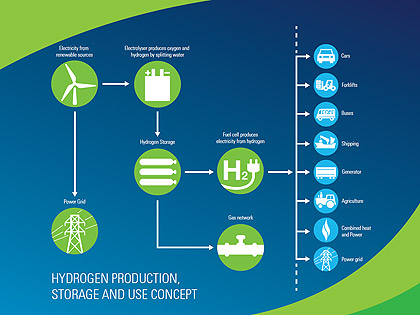Hydrogen is the most basic and common element on Earth. It has been used as an industrial gas for over 100 years.
Very little hydrogen occurs naturally on Earth on its own. It is found in compounds like water and hydrocarbons such as fossil fuels.
Electrolysis can be used to produce hydrogen, by splitting water (H2O) into hydrogen (H2) and oxygen (O2) using an electrical current. If energy from renewable sources is used to power this process the hydrogen can be produced with zero carbon emissions.
Working efficiently and effectively in countries around the world, hydrogen is a proven technology, with a wide number of practical applications in transport, heat and power.
With an ability to store energy, hydrogen offers a solution to energy supply and demand constraints that can be experienced in renewable energy. Once produced, hydrogen can be stored and used to generate electricity at times of peak demand for use in all sorts of applications, including transport, heating and power supply, requiring less dependency on the grid.
This energy storage capacity can help manage the energy generated by variable renewable sources, such as wind and solar, storing any energy surplus for later use when needed.

Hydrogen transport
With just under a quarter of Scotland's emissions coming from transport, achieving long term sustainable transport solutions is a significant step forward in the transition to a low carbon economy. The use of hydrogen in transport offers great promise as a key component of a low carbon energy system.
When made using renewable energy, and used in a fuel cell, hydrogen can provide a zero emission fuel, which produces water vapour, instead of CO2 and other harmful emissions.
With no harmful emissions from the exhaust, hydrogen fuel cell vehicles can help to improve air quality and reduce air pollution. Hydrogen fuel cell buses have additional benefits, being quieter to run than conventional buses and providing smoother acceleration.



